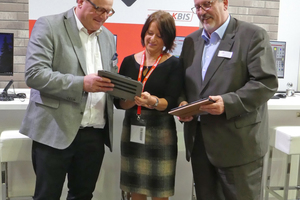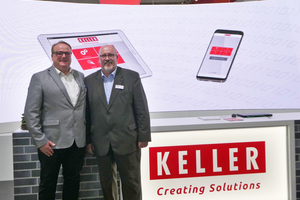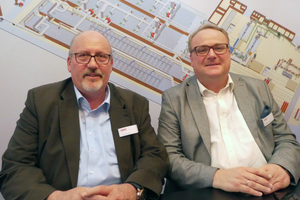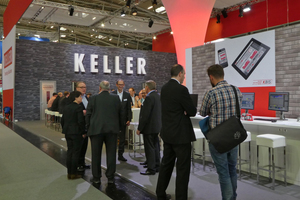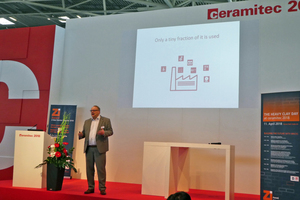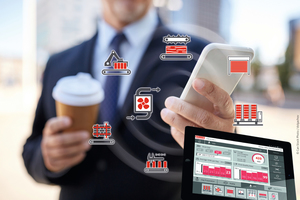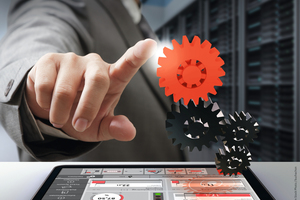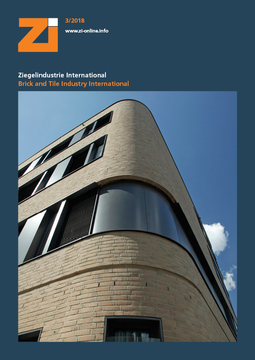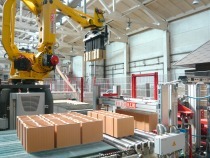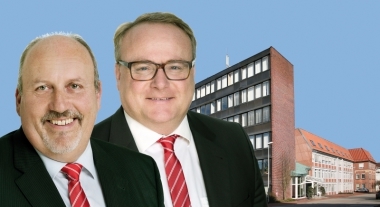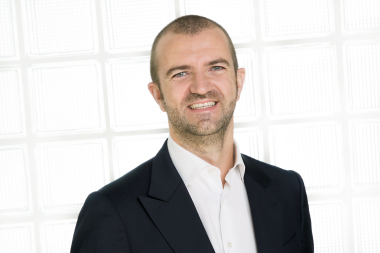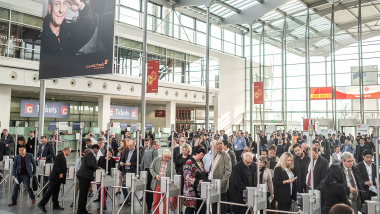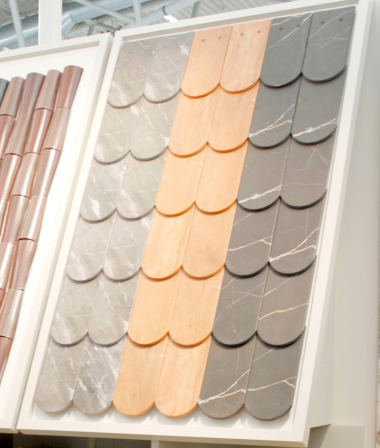Working together – with customers and in our own team
At ceramitec in Munich, Keller featured digitalization centre stage. The plant engineering company presented two digital solutions, first the information platform KBIS, and second KPES, a web-based solution designed to steer project execution. We spoke to CEO Uwe Hartmann, and COO Stefan Reichert, who have been managing business at Division Keller since late 2017.
U.H.: The first thing we asked ourselves is: How can we be more flexible and closer to our customers, and how can we achieve this internally, too? To attain this flexibility both internally and externally, we have restructured the company. To this end, we have introduced four business units, which will be presented on an equal footing as part of our external image: Intelligent Ceramic Solutions (ICS), Intelligent Machinery Solutions (IMS), Intelligent Automation Solutions (IAS) and Infrared Temperature Solutions (ITS). These are all supported by our Service unit. The essential change is that alongside the expertise for heavy clay ceramics that we have offered up to now, Keller’s other core competences will be positioned as separate units on the market. Synergies from heavy clay ceramics are used for the IMS unit, which supplies highly flexible machine- and robot-assisted systems for industrial handling and palletizing processes. The IAS unit is also benefitting from these synergies. The business units are identified with their own sales for each unit and defined as knowledge units.
S.R.: All the other departments behind these units are classed as competence centres, that is the knowledge units will be supported with expertise from these centres.
Our key catchword is “together”! Communicating with each other is practically impossible in a hierarchical system. There are always bottlenecks, with information being lost and extreme difficulties in, for example, getting new ideas to the right place at the right time. It is simply impossible to make important information generally transparent. Working together only functions properly if you work with a matrix. This “together” approach doesn’t just apply to our work in-house, but also refers to “with our customers”. We are striving for sustainable understanding, that is mutual understanding within the company, with our customers and for our customers, too. You can’t just deliver something to a customer and then abandon him alone with it. Here we envisage a long-term relationship, which is already established during the initial talks on a project and must be maintained when the project is realized and also after it has been realized. To ensure this working together, the continuation of the project, we have decided to push ahead with digitalization.
U.H.: Digitalization is our core topic at ceramitec, and we are showcasing that with two new developments: One is the service app KBIS, the Keller Bolt Information System. Here information from plant components or integrated plants is quickly collated and shown in a simple, easy-to-understand display on an app. Customers can use this app as a cockpit where they can view their data using modern media, be it on their smartphone, tablet or PC, that is the information is no longer reserved for the operative at the control panel.
S.R.: And this cockpit enables them, depending on the level they choose, with the help of a very easily accessed icon to view this data in real time. It is their plant, their data. They can look at the data wherever they may be, whether they’re on a business trip, working in the office or perhaps having dinner with friends. The system is, of course, also intended to give the customers other information, like operating instructions or maintenance guides. And in a further step, they can easily order replacement parts in this system, that is they can identify the replacement parts in a first step and then order them.
U.H.: The second highlight that we are presenting here at the trade fair is the KPES system, that is the Keller Project Execution System. This system is about collecting information that is available in our systems again in a simple display in a cockpit system. The objective is to collect and display in a simple and well-structured overview all the information relevant for a project in this system. This information includes budget, execution status and so on. These are, of course, internal data first. But if we at Keller have these data and also the schedules, then the customers should have them, too. The customers then know how far a project has progressed, they see the agreed dates, when supplies should arrive at the installation site, etc. DHL, Amazon, they all have a tracking system, it’s just in plant engineering that we still do everything manually by telephone. Keller has invested in this project, and in future the components will be dispatched and trackable for the customers.
KPES is an intelligent tool, in which the data of a project are made transparent and the customers see the same data, dates, project milestones, etc. that we see.
In addition, we are introducing a twin-track ticket system, on the one hand for us internally and on the other hand for the customers. If, for example, our fitters need a part on site, then they can request this via the ticket system and the order proceeds on a defined route through the company. The employee at the installation site has the option to track where his part is at a certain time and when it will reach him. This ticket system will also be available for customers. The customers, too, have the possibility to make requests or specifications concerning a project to the company, which then run through the company in same way. Of course, the customers get feedback on where their request is and how far the request has been processed. The system doesn’t replace communication by e-mail or telephone. I am, however, sure that it is very useful in the case of certain priorities to track whether a request is being processed at all, where it is being processed and whether the customer is updated about its progress. We in the management can establish where a request is being held up at a certain time, internally or externally?
S.R.: We want to make the whole process more effective. In practice, as you brought this up, it is often the case when, for example, a part is needed that the field operative has to ring the project manager, who then rings the company – that triggers a “communications circus”. That means the employee has to clear supply of the part with purchasing, the design department, the dispatch department, and external advertising. He has to make 15 telephone calls before he knows how to get the part. We want to simplify this. Because the whole process costs an awful lot of time, this system will steer and control it. A personal meeting is always more important. But it will increase efficiency in principle if traceability and transparency are given. That is what we want. Working together, for our customers, with our customers, within our company.
U.H.: We are starting as of immediately with the new projects, Naturally, we want to set ourselves apart from competitors, we want Keller project management to be highly professional and set the bar very high on this market.
We understand a project as a partnership with our customers. And I am firmly convinced that we can only be successful in the high-tech segment if we can ensure an intensive and close relationship with our customers. That means, of course, that we don’t just abandon customers once we have delivered and commissioned our machines and equipment. We want to offer 360-degree service. Our customers have to feel that they are in good hands with us, we always have to work closely with them and keep an open ear for customers’ needs and concerns. There is always something to do, naturally, we also live from replacement parts, but from service, too. One plan is also to do customer audits to give customers the feeling that Keller is genuinely looking after them.
U.H.: With a highly flexible organization to be able to react to changing markets, and with digitalization. The third thing is highly professional benchmarking by the management, using synergies within the business units and between the business units, analysing and defining markets, by market segments and target groups.
S.R.: Precisely, we have to clearly identify what is the market, what is the market segment, what is the target group? If there is a market, we have it analysed. What is the core expertise that we can supply, can we meet the market’s needs? This market can be in heavy clay ceramics but can also be oriented to other segments providing we can satisfy the core competence requirements. But in the heavy clay ceramics market, for instance, there is also a market segment for service. What is the target group there? There are two: there’s the plant manager and there’s the one actually working in the plant. If we follow this analysis and look at KBIS, then it follows this logic precisely. This product simply satisfies the needs of both target groups in the service segment.
U.H.: For this year, we have plenty on our books and the prospects for next year are already very positive, both in our core business of Intelligent Clay Solutions (ICS) and in the other business units. Traditionally, the Intelligent Automation Solutions (IAS) runs very well every year and is not as volatile as the ICS business. The fact that business is also going so well in the ICS core area this year is very gratifying because it also gives us the possibility to realize aspects such as digitalization and KPES.
U.H.: We assume that simply a lack of courage in Europe is preventing any decisions being made quickly. We have, however, observed after relatively long analysis that outside Western Europe there is much greater flexibility when it comes to looking at this development. There we are in talks, the outcome of which we are analysing to see how we can initiate the next steps. But things will in any case go on. With Enviro, the goal is to achieve an energy saving. Energy prices aren’t currently high enough for someone to take the courage to say okay, we’ll work with Keller in a joint project and put up the money for it. Energy isn’t really at the top of the list of priorities in Western Europe at the moment.
S.R.: We believe that there are different markets. We have also used this trade fair to look how digitalization is received in the market. You can’t actually say that there isn’t any interest somewhere, everyone has some interest. Differences will probably lie in the detail realization, depending on the individual country, and the different markets. We find that working with and transferring data is more the norm internationally than in Germany itself. For this trade fair we have drawn up a 14-point catalogue and discussed this with those interested, which should help us make the right decisions.
U. H.: With regard to heavy clay ceramics, it will be part of every new project as standard. The basic preconditions are all there, i.e. the interfaces, the data sources, etc. are there. We are, however, planning to sell it proactively in negotiations, too.
S.R.: You only need two things. The customers need sensors, a router and have to be capable of sending data. And we have the app itself to process and return the data. The technical preconditions, the sensors, the data and their transfer are already included in the project. And if the customers actually want to use it, they buy KBIS!
U.H.: Our service manager Michael Schmitz assured me just last evening that we shall be right up there next time around. Because we are now implementing all these things and take closeness to our customers very seriously, internalizing the service concept. We shall take our customers with us with customer audits to ensure our presence at the customers’ plants, holding the concept of service high.
S.R.: A very positive one! I have been watching our team and also monitoring the mood at the trade fair. Yesterday, someone said they had the feeling that things were really moving at Keller. We have conducted very concentrated talks on digitalization and the feedback from our employees is that we have really hit the nail on the head with this topic. My assessment of this trade fair is absolutely positive. We are taking away a load of information, lots of contacts and also lots of ideas on which we can work in the future.
U.H.: That also applies to our employees. We focussed on not only having our sales team here, but that an average cross-section through our company is represented: field operatives, project managers, employees from design, from the laboratory and other areas have been here. Just like our sales staff, employees from the laboratory and the project manager have held sales talks on KBIS – the field operative has presented KPES and the other way around. Within the team a great togetherness also and particularly with sales could be felt. Seeing the motivation and joy in the eyes and faces that is certainly one impression that we are taking home from the trade fair.
We can only come back to the trend of digitalization. This will go on as we are only at the very beginning. Here in the neighbouring halls at the trade fair, we have seen that they are much further in whitewares than we are. The subject of digitalization – virtual reality – which is already commonplace in the consumer sector, will make inroads in our industry, too. There are concrete ideas about how we want to develop further here. We are right at the beginning, there is a long way to go before we reach the end. That isn’t just a phenomenon in heavy clay ceramics. The skills shortage, for instance, is an issue all over Germany. It is extremely difficult to find employees, and digitalization offers a possibility to optimize resources in future. Today, if I have to fix a problem at a customer’s facility abroad, then the relevant employee is away for a week and only does this one thing in that time. With automation and digitalization, we expect to be able to offer the customer far more support from our base in Laggenbeck. We can deploy our employees much more efficiently and don’t tie them up in single assignments. You mustn’t forget that with the younger generation, a different type of field operative has emerged. Field operatives used to be abroad for weeks and months on end. Nowadays, much more value is attached to family, and we support that. That is also important for working together. You can only get this under control if you work with precisely these media. Apart from that, you save on travel costs. And for the customers help is on hand much, much faster. They can send us a request and get the expertise to help relatively quickly. I can feed in images, give them tips or stream entire videos showing them how to do something. And there are new possibilities for this. Here at the stand we have 3D glasses with which you can go directly into a plant layout and train certain actions. With this system, it is possible to safely direct highly qualified work and reliably eliminate downtime, that brings both a time gain and cost saving.
Incidentally, we are always looking for qualified employees, especially in automation, because we want to further develop this area.
Mr Hartmann, Mr Reichert, many thanks for this interesting talk here at ceramitec. We wish you every success with your new digitalization strategies and look forward to you informing us about customer applications that you have realized and further progress when the time comes.
Keller HCW GmbH
www.keller.de

